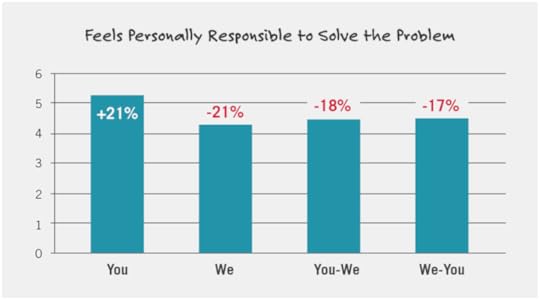How Science Can Save the Lost Art of Direct Response Copywriting
The post How Science Can Save the Lost Art of Direct Response Copywriting by Steve Jones appeared first on Corporate Visions.
[image error]

Back in my day, I had to walk ten miles uphill each way in three feet of snow to get to and from school (even though I lived in the California Bay Area). When I finally got home, I’d have to listen to music on a record player with vinyl albums that warped, scratched, and skipped (oh, sorry—for some reason that’s cool again).
Anyway, the other thing I remember about olden times was that demand generation and marketing campaign professionals used to be experts at direct response copywriting!
We didn’t have 7,000 different marketing technologies to master. We couldn’t assume if the campaign was programmed right, it would work. We focused on writing a punchy, compelling story with a powerful call-to-action, walked to our nearest mailbox or fax machine, and sent that message out.
Do I sound like a cranky old marketer yet? Well, that’s how
I choose to remember the “good ol’ days.” In reality, my wonderful mother drove
me to school every day and when I got home, I actually spent hours listening to
state-of-the-art sounds on clear, indestructible CDs. (It’s fair to say that as
you get older, you tend to exaggerate most things from your past).
Unfortunately for many demand generation professionals today,
their inability to write a compelling, cohesive story is no exaggeration.
Somewhere along the way, direct response copywriting became an underdeveloped
and underappreciated marketing skill. But it’s not necessarily their fault.
Keeping Up with Complexity in Direct Response Copywriting
Campaign Managers’ jobs have become increasingly complex
over the years. They need to keep up with ever-changing marketing automation
solutions, CRM systems, social media monitors, buyer intent data, digital
marketing platforms, analytics tools, and much more. And on top of that, you’re
likely asking them to carry some form of “quota.” Maybe not a bookings quota
like a sales rep, but make no mistake about it—most have Inquiry, MQL, SAL, and
SQL targets they absolutely must hit.
With so much being asked of them, it’s no wonder campaign
managers don’t spend time honing their writing skills. But in the face of ever-increasing
pipeline goals and revenue targets, the question becomes, can they afford
not to?
Don’t get me wrong; technology is critical. It enables your campaign
managers to work more efficiently, allowing them to get in front of more
qualified buyers than ever before. But if you aren’t telling the right story,
at the right time, in the most compelling way possible, then technology really only
helps you get your bad message out to the exact prospects you simply cannot
afford to whiff on.
If you really want to generate more marketing qualified
leads and build a growing pipeline, don’t look for yet another shiny new
software tool—get back to basics. Help your demand generation team improve their
results with these copywriting tips.
Science-Backed Direct Response Copywriting Tips
“You” phrase your campaigns
Can a single word impact how your prospects react to your
messages? Specifically, should you use the word “we” or “you” to in your
campaign messages?
Even the most seasoned writers might deliberately use the
word “we” to establish a sense of shared purpose with their audience. And in
theory, it makes sense. You try and show that you understand your prospect’s
world and you can be trusted as a member of their tribe.
But according to our research, we-phrased messages are considered less thought-provoking and less engaging than you-phrased demand generation messages. The study found that your prospects feel more personally responsible for solving the identified problem from a you-phrased message, as opposed to a we-phrased message.
[image error]

This is crucial because you want your prospect to take ownership of the issue and be willing to champion the opportunity. So, the next time you write an email, write with you-phrasing. It’s a small change. But it makes a big difference.
Learn more about you-phrasing in our State of the Conversation Report,The Impact of You-phrasing on Customer Conversations.
Get smart about personalization
With more sophisticated technology driving an ever-swelling sea of customer data, you may have a natural temptation—even an organizational imperative—to use it all, every time. After all, those systems cost money and promised big ROI. But at what point do the scales tip back? Is there such a thing as too much campaign personalization, specifically as it pertains to Account-Based Marketing (ABM)?
A recent Corporate Visions field test shows that you don’t
need to hyper-personalize every email campaign. According to the study results,
open rates were higher when using more personal details about the prospect, but
the opposite was true for click-throughs. Personalizing
by industry (without personal details) returned a 24 percent
higher CTR than the company + personal details treatment.
[image error]

By focusing on the approaches that drive the most meaningful
results at the first touch, you can scale more quickly and effortlessly—while
delivering even better results to your sales teams.
Read our e-book, Putting Personalization to the (Field) Test, for more details and example emails from the study.
More Quick Tips
In addition to the research above, you can also brush up on
these direct response copywriting tips.
Lean into the tension. Highlight common trends and
challenges that keep your prospects from achieving their goals
Make your copy strong and active. Use powerful verbs
and active voice.
Connect their pains to your solutions. Create a
coherent transition from your prospects’ pains to how your solutions can help solve
them.
Don’t be afraid to sound human. Avoid filler words,
fluff, and buzzwords.
Close with clear next steps. Make sure you close by
giving your prospect a clear, well-defined, and—most importantly—EASY way to
take the next step.
In Conclusion
As technology progresses, campaign managers can generate leads more efficiently than ever. But direct response copywriting is still at the core of every successful demand generation campaign. If your campaign managers aren’t telling a compelling story that makes your prospect want to take immediate action, you’re likely missing out on leads, pipeline, and ultimately, revenue.
With Corporate Visions skills for marketers, you can increase the efficiency and effectiveness of your messages, content, and campaigns through decision science-based consulting and training programs:
Tested and Proven Messaging Skills Training for Marketers Message Consulting and Marketing Content DevelopmentSales Message Launch, Practice, Coaching, and Certification
Contact Us to Learn More.
Thank you for reading this post from Corporate Visions - Differentiate Your Marketing Messages and Sales Conversations.
Timothy Riesterer's Blog
- Timothy Riesterer's profile
- 3 followers



